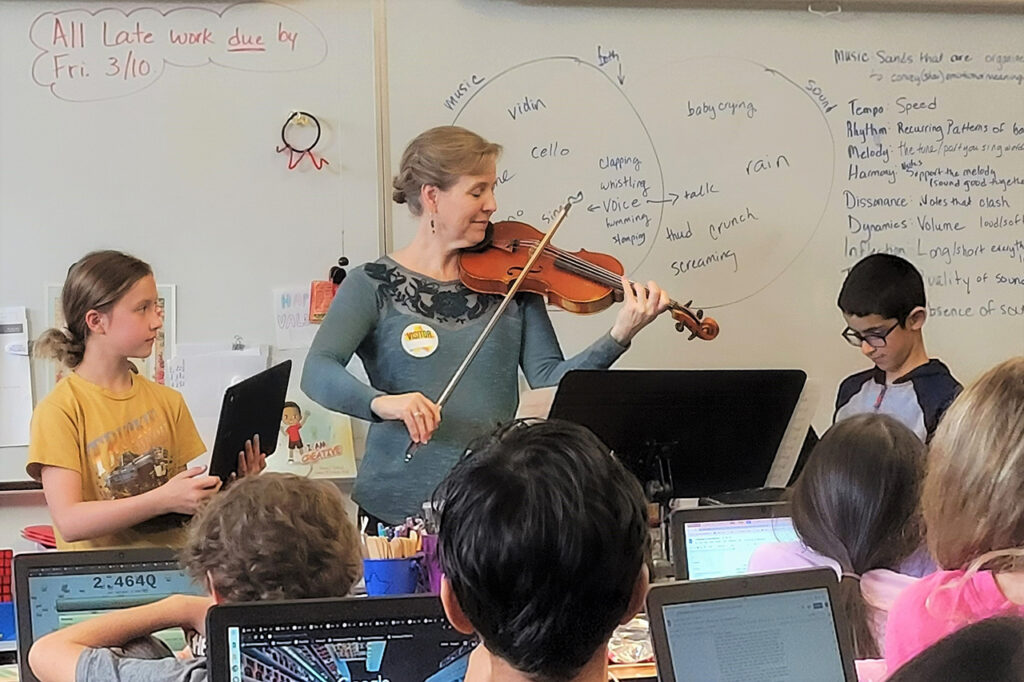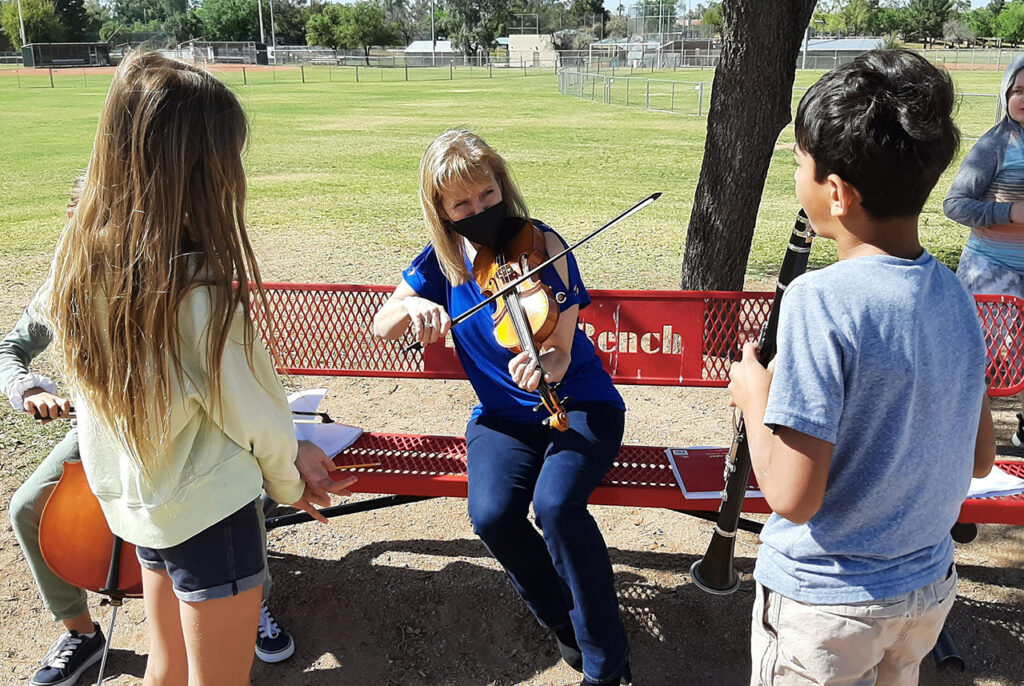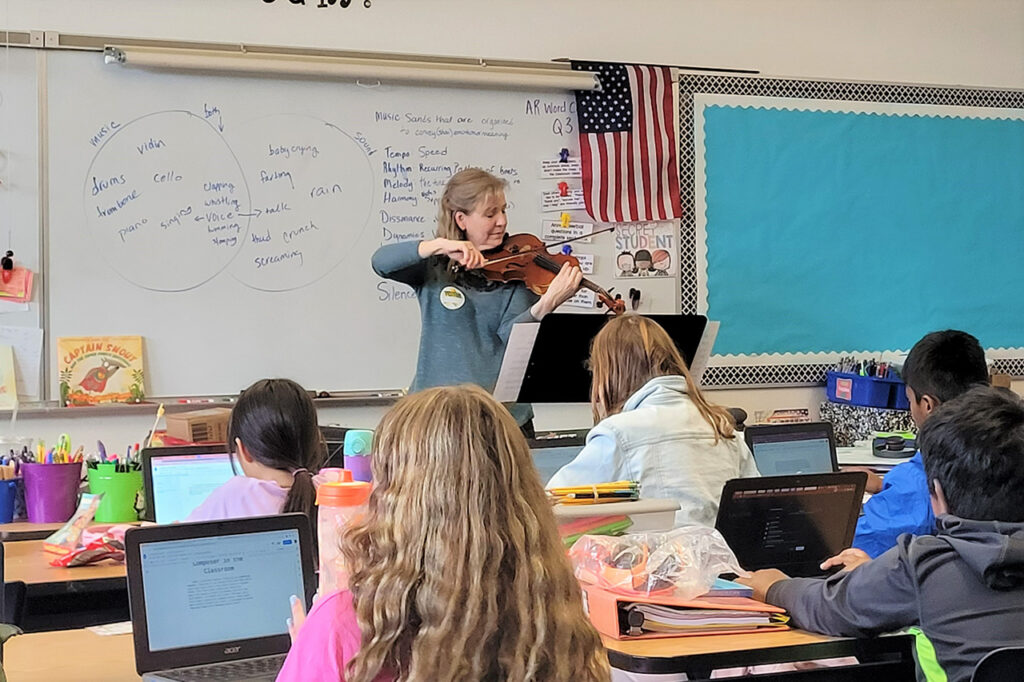Scottsdale Arts Uses Music to Teach Writing
The programs of Scottsdale Arts are not just about the performances and exhibitions we produce on our campus in Old Town Scottsdale. Each school year, our Scottsdale Arts Learning & Innovation department brings arts-integrated learning to classrooms across the city, primarily working with Scottsdale Unified School District and Paradise Valley Unified School District.
Many of these programs fall under Scottsdale Arts Learning & Innovation’s arts integration work. The Kennedy Center describes arts integration as “an approach to teaching in which students construct and demonstrate understanding through an art form. Students engage in a creative process which connects an art form and another subject area and meets evolving objectives in both.”

Among these arts integration programs is Composer in the Classroom. Offered for grades 3–10, Composer in the Classroom explores the intersection of literacy and music, empowering students to tell stories through sound. Scottsdale Arts contracts with professional artists to take this program to local students.
Dian D’Avanzo, assistant concertmaster at The Phoenix Symphony, is one of those artists.
“I’ve been to a lot of different schools now, which has been fun,” says D’Avanzo, who has been working with Scottsdale Arts’ Composer in the Classroom program for five years.
Participating schools have witnessed the effect D’Avanzo has on their students. Brandy Wilson, who teaches 5th grade at Navajo Elementary School, says the students were attentive and focused when D’Avanzo was in their classroom—always curious about what the musician would perform or say next.
“They were excited to share their expertise and to hear about hers—in awe of her skill and that she played in the Phoenix Symphony,” Wilson says.
D’Avanzo was born in Minnesota to a mother who taught art and music. When her mother quit teaching, she redirected that energy toward her own children, starting piano lessons for D’Avanzo when the fledgling musician was only 3 years old. But by age 10, D’Avanzo had decided to pursue the violin instead.
“It’s always hard to practice,” D’Avanzo says. “But with my mom being a teacher, that was mandatory. One of the reasons I switched to violin was because having your mom as a teacher is rough.”
She also began to study harp at age 12, but her focus remained on the violin, earning a bachelor of music from the University of Minnesota and a master of music from the New England Conservatory in Boston.
After finishing her education in 1990, D’Avanzo joined the New World Symphony in Miami Beach, Florida. She had been there only two weeks when the symphony’s planned tour to Spain was canceled. With nothing to do, she flew to Arizona to audition for the position of assistant principal second violin with The Phoenix Symphony—a position she received.
Since that time, she has had engagements with the Santa Fe Opera Orchestra, the Arizona Opera, and the Utah Festival Opera. She was also part of a live performance on A Prairie Home Companion. She plays a violin made by her brother, David Folland, one of the finest luthiers in the country.
And she regularly inspires young students through Scottsdale Arts’ Composer in the Classroom lessons.
When Christine Harthun, residency and curriculum coordinator for Scottsdale Arts Learning & Innovation, approached her about the program, D’Avanzo felt comfortable jumping right in because she and her husband, Michael, a cellist for The Phoenix Symphony, had experience with the symphony’s own educational outreach programs.
“I was really surprised at how fulfilling it was. It felt really important. And I had no idea it would be like that.”
— Dian D’Avanzo, Composer in the Classroom teaching artist
For the Scottsdale program, Harthun provided an initial outline of Composer in the Classroom to D’Avanzo, who then filled out the concept for how it would work with her participation. Through the years, D’Avanzo says the teachers who invite the program into their classrooms have also helped refine it. Though it became more challenging to offer the program during the COVID-19 pandemic, they worked together to find an online program that would help them fill in the gaps.
The Program
First, D’Avanzo says she begins with a few questions: what is sound and what is music? She spends that first day in the classroom with each new set of students exploring the differences between sound and music, challenging them with things like the theatrical show STOMP, which uses unconventional methods of creating percussive music. If they aren’t using traditional instruments, is it still music?
“They eventually come up with: ‘music is organized sound,’” she says.
But then D’Avanzo shows a video with organized noises that most would not consider music, enabling her to talk about how composers are always changing the definition of “music.”

Next, with D’Avanzo playing pieces for the students on her violin, they explore how a composer turns sound into music using things like melody, harmony, rhythm, and tempo. They talk about dynamics and the role of silence in music. For some of the students, these are known concepts; for others, it’s a whole new world.
“I have some kids in there that are little musicians,” D’Avanzo says. “And I have some kids in there who have never touched an instrument at all.”
They also discuss how the music makes them feel. Through this exercise, D’Avanzo has them create a character to star in a story told by music. This helps the students listen carefully to the music for direction on what might be happening with the character at that point of the story. Teachers like this exercise because it helps students who have previously struggled with writing.
“At the end, they get them to come up and read their story, and I’m basically the soundtrack to their story,” D’Avanzo says.
Wilson, the Navajo Elementary School teacher, says her students have been more interested in each other’s writing and ideas because of their participation in Composer in the Classroom.
“I saw an increase in student collaboration, curiosity, building the classroom community, and engagement. I’ve never seen them write so much in one sitting in such a short time.”
— Brandy Wilson, 5th-grade teacher at Navajo Elementary School
Another aspect of the Composer in the Classroom program is taking existing stories—from Fahrenheit 451 to The Legend of Sleepy Hollow—examining the mood of the tales and determining the type of music that fits them. Are the stories sad, or maybe anxious? What type of tempo matches the action of the story? What instruments might sound best in the soundtrack?
D’Avanzo says the students will often indicate how they want it to sound and then ask her how to make it sound that way. After the students compose the music with D’Avanzo’s help they perform it together for their classmates.
Those performances often include students playing instruments. Some who are musicians bring in their own instruments, from strings to saxophones. And typically, the music teachers at each school have a variety of percussion instruments for the non-musician students to use. D’Avanzo adds a few of her own instruments—a guitar, a ukulele—to the student band, in addition to playing her own violin with them. Students who are experienced with music composition programs may even create recordings at home to add to the mix.

Alison Bunde, a former 4th grade teacher Hopi Elementary School who had the program in her classroom, said many students are unsure about whether they will be able to compose anything. But that changes over the course of the weeklong program.
“By the end of the week, they are confident in performing the composed piece in front of their peers,” Bunde says. “This happens because they are learning so much and so well with Dian.”
D’Avanzo notes that she herself is not a composer. But she uses Beethoven’s 5th Symphony to show them how simplicity can also be powerful. It’s among the most popular pieces in classical music, yet it’s based in variations on a fairly simple theme.
She also brings the discussion into modern times by noting how contemporary artists use samples of other songs or melodies to compose.
“There are so many ways, now, to be a composer.”
— Dian D’Avanzo, Composer in the Classroom teaching artist
While Composer in the Classroom is currently only offered for select grades, D’Avanzo recently participated in Scottsdale Arts Learning & Innovation’s Summer Institute, where she presented the program to instructors who teach a variety of grade levels and received feedback from them to help improve the program.
Among D’Avanzo’s most rewarding experiences was a conversation with a student who speaks English as a second language. He told her that he struggles to communicate through words, but the program had taught him there are other ways to communicate. “I love that I’m able to communicate through music,” he told her, adding that he had even made new friends through the composition project.
Teachers have also seen the transformational effects of the program on their students. Wilson, from Navajo Elementary School, noted one student, in particular, whose writing had benefited from added expression and dialogue following the program.
“In fact, she couldn’t stop writing,” Wilson said. “I saw more students pick up on the climax of the story and the resolution than in previous lessons I’ve taught in class. This assisted them in learning the art of writing in so many ways.”
Composer in the Classroom is part of Scottsdale Arts Learning & Innovation’s Cultural Connections Through the Arts, a classroom-based, arts-integrated residency program led by professional artists and master teacher trainers designed to support classroom curriculum. Learn more at ScottsdaleArtsLearning.org or email [email protected].
Back to Spark home.
CONNECTIONS: Amplify | Immerse | Inspire



